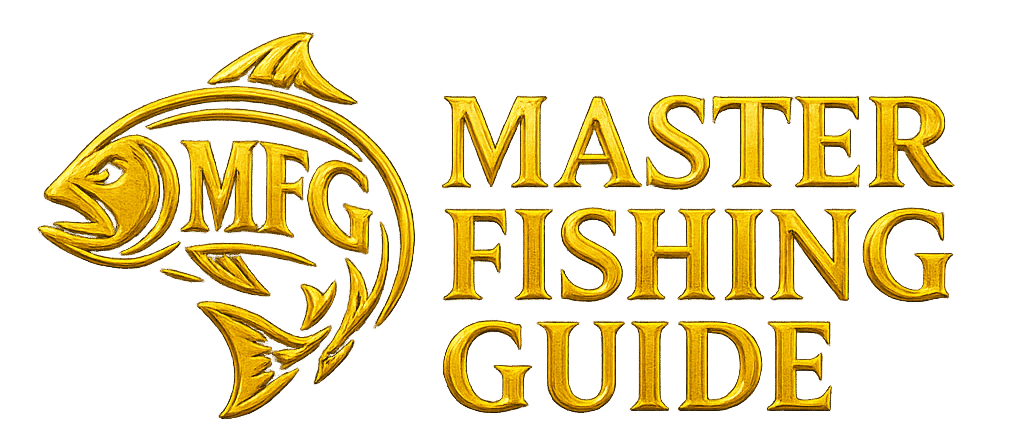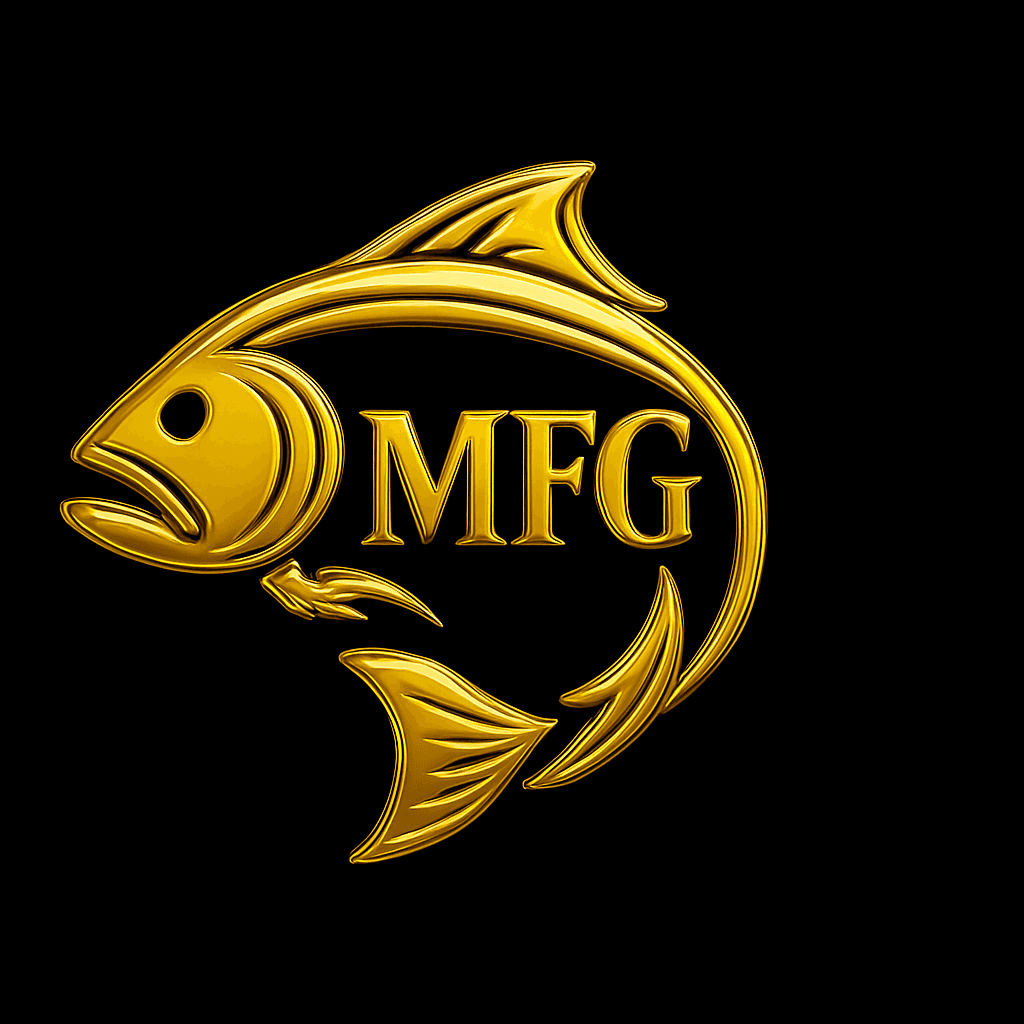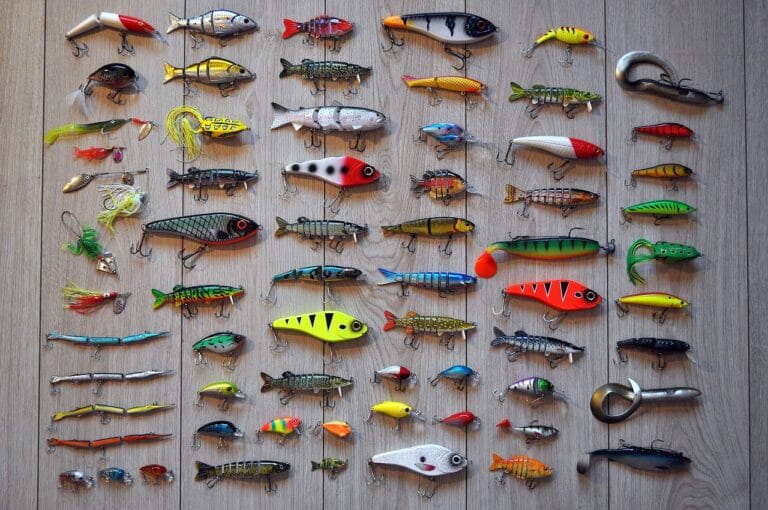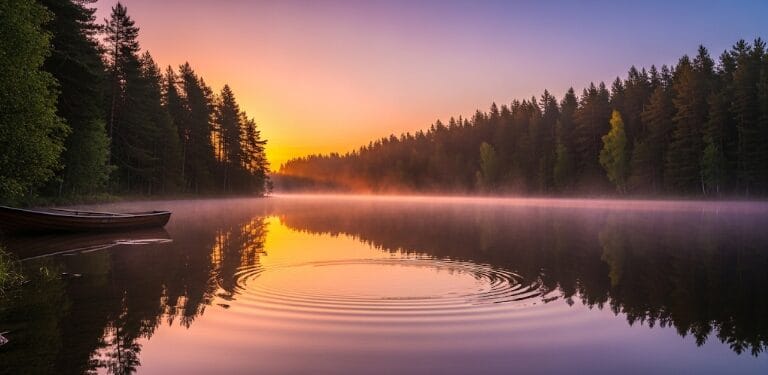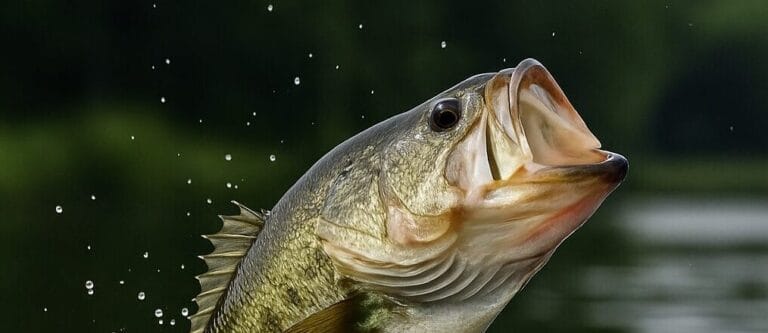Where to Find Bass: Proven Spots by Season, Structure & Water Type
We’ve spent years studying how bass move, feed, and react in different types of water — from calm ponds to deep U.S. reservoirs. Through hundreds of hours on sonar, drone footage, and real-time mapping, one pattern stood out above all: bass are never random. Every move they make follows structure, temperature, and available food.

As an Amazon Associate, we earn from qualifying purchases — no cost to you. That’s how we keep this site running. Read more ›
That’s what this guide is built on — real observations from countless trips, tested patterns, and verified data from U.S. lakes and rivers. If you’ve ever asked yourself where bass actually hide when you can’t find a bite, this is where you’ll get clear answers.
How Bass Decide Where to Stay
Bass don’t just swim around waiting to get lucky. They set up in very specific spots that give them food, comfort, and protection. Once you understand these three elements — structure, cover, and current — you can predict bass locations with surgical accuracy, in any water and in any season.
Seasonal Bass Locations
Every season shifts where bass hold, how far they travel, and how aggressively they feed. Track water temperature first, then read structure, cover, and current. When two signals line up (bait + comfort), stop and work the area; when all three align, you’ve found a high-percentage zone.

Spring: Where Bass Stage, Spawn & Slide Out
Temp cues: ~50–60 °F (10–16 °C) = staging; ~60–65 °F (16–18 °C) = spawn windows. Expect overlapping phases on big systems.
Primary structure: secondary points, channel swings that kiss the bank, inside turns leading into protected bays, sun-facing gravel flats.
Micro moves: After a warm front, fish push onto the warmest bank (sun + wind); after a cold snap, they drop to the nearest break or swing — often just a few meters deeper.
Where to start: mouths of coves → secondary points → first hard bottom on the spawning flat. In clear lakes, watch rock transitions (mud→gravel→chunk rock). In stained water, the bite often stays shallower all day.
Why it works: staging areas are “intersections” bass use multiple times (pre-spawn in, post-spawn out). Work from deep to shallow, then reverse.
Summer: Deep Structure by Day, Shallow Windows at Low Light
Temp cues: ≥75 °F (24 °C) compresses comfort zones; thermocline sets a hard ceiling/floor on many reservoirs.
Primary structure: main-lake points, ledges, offshore humps, channel bends, bridge pilings; in grass lakes — outside edges and holes with active oxygen release (midday sun).
Daily rhythm: Low light (dawn/dusk) = shallow feeders on windy banks and over grass; midday = deeper edges or suspended fish on breaks and over bait schools. Night windows can be excellent on pressured waters.
Where to start: graph points/ledges for bait + hard spots; fish the windward side first. On rivers, target current seams behind wood/rock where oxygen and food funnel.
Fall: Follow the Bait Into Creeks & Wind Lanes
Temp cues: cooling below ~70 °F (21 °C) pulls shad and other forage into tributaries; bass track them in “steps.”
Primary structure: transitional points, drains, backs of coves with bait, wind-blown banks that stack schools.
Behavior: groups tighten up and feed in flurries. Expect blitz bites around edges where depth changes meet wind. Cover matters less than bait + movement — keep relocating until you visibly mark/see life (sonar, birds, surface flickers).
Where to start: mouth of creek → mid-section intersections → back flats; repeat until you intersect bait. When life disappears, back out to the last point holding bait.
Winter: Steep, Stable, Close to Deep Water
Temp cues: <50 °F (10 °C) = energy conservation and tight depth bands; smallmouth often group deeper/rockier than largemouth.
Primary structure: bluffs, steep banks, main-lake points adjacent to channels, deep rock piles and subtle heat-holding rock; slowest river sections with consistent flow.
Stability first: seek protected water from cold wind and spots with repeatable sun exposure. Many fish hold weeks in the same “winter holes.”
Where to start: outside channel turns that touch steep banks; scan for bait near bottom contours. If nothing shows in 10–15 min, slide to the nearest point or the next channel contact and repeat.
Bass Habitat by Water Type
No two fisheries are identical, but bass always favor certain habitat types depending on the water body. Knowing where bass hide in lakes, ponds, or rivers gives you a serious edge — especially when exploring new water.

Lakes & Reservoirs
In larger lakes and deep reservoirs, bass spend their lives cycling between shallow feeding zones and deep structure routes. They use main-lake points, creek arms, and channel bends as predictable highways connecting shallow spawning flats to deep water safety zones. Wind direction decides which side of a lake becomes active, since bait naturally drifts toward the windward side where predators wait.
Structure changes like ledge drops, sunken timber, and rock transitions create ambush lines that bass use year-round. As temperatures fall, they follow the same structural paths back toward deeper winter holes — a pattern explained in our winter section.
Ponds & Small Lakes
In small ponds, oxygen and temperature shift rapidly, and bass react just as fast. They favor inflow areas where fresh water enters, dam faces where depth changes quickly, and submerged cover that offers shade and ambush points. Shallow edges near drop-offs are magnets for bass during feeding windows.
When a cold front hits, pond bass slide toward the deepest available cover and slow their movement — the same behavior described in cold-water conditions. Subtle presentations and compact lures that stay longer in the strike zone often outperform fast-moving baits here.
Rivers & Streams
Current changes everything. Bass in rivers position based on flow strength, cover, and oxygen. You’ll find them behind current breaks, bridge pilings, and outside bends where food naturally funnels. On high-water days, they shift closer to the bank into slower pockets.
Controlling your lure in moving water demands precision. A sensitive setup with balanced rods helps detect subtle strikes and maintain control over line tension in current — something most beginners underestimate.
Mixed Habitats & Transitions
Transition zones often hold the biggest fish because they combine comfort and opportunity. Focus on edges where grass meets rock, mud turns to gravel, or wood touches deeper drop-offs. These subtle shifts create feeding corridors that bass revisit through every season.
When obvious cover stops producing, shift your approach and experiment with lure speed or angle. Versatile lures that mimic baitfish movement excel in these areas, especially when bass are transitioning between summer and fall feeding modes.
How Wind Affects Bass Behavior & Bite Timing
Wind is one of the most underrated tools in bass fishing. Most anglers hide from it — the best ones use it. A light or moderate wind changes everything: it moves plankton, pushes baitfish, and breaks surface glare so bass feel safer feeding shallow. When you understand how wind direction, strength, and duration influence bass, you start turning “tough days” into your best ones.

Wind Direction and Bass Movement
Always fish the windward side of a lake or cove. Wind blows plankton and small bait into that bank, creating a natural feeding lane. Bass stack up on points, grass edges, and rocky banks that face the wind because that’s where the food is. A calm, sunny cove might look perfect — but the windy side almost always produces more bites.
When wind blows into a bay for several hours, it also slightly raises the water temperature and oxygen level near the surface. This is why active fish often feed on wind-blown flats even when deeper structure looks ideal on sonar. Bass go where the food and comfort meet — and wind usually decides that location.
Wind Speed and Lure Choice
As wind speed increases, visibility drops underwater. That means bass rely more on vibration and silhouette than detail. It’s the perfect moment for moving baits — spinnerbaits, crankbaits, and chatterbaits — especially in stained or choppy water. Their vibration and flash cut through turbulence and trigger instinctive strikes.
In strong winds (above 15 mph), focus on reaction bites. Fast retrieves, tight wobble crankbaits, and bright color contrast work best. Wind diffuses sunlight and makes bass less cautious, so you can fish aggressively without spooking them.
Timing and Pressure Changes
Wind rarely acts alone — it almost always follows or precedes a pressure front. A light breeze before a front often signals a feeding window; heavy wind just after a front can shut things down for hours. That’s why top anglers always track barometric changes. When you feel that soft, steady south wind turning to gusty northwest, adjust your presentation before the bite dies.
In stable conditions, keep your presentation subtle. When wind picks up and clouds move in, switch to faster, louder, and more visible baits. This simple adjustment matches how bass see and sense prey in different water turbulence levels.
Pro Tips for Fishing Wind Effectively
- Face the wind when possible — cast into it or across it to mimic natural bait drift.
- Target wind-blown structure — points, riprap, and grass edges become feeding stations.
- Use heavier lures for control — 3/8 to 1/2 oz spinnerbaits, lipless cranks, and jigs cut through waves easier.
- Keep boat control simple — use a drift sock or spot-lock instead of fighting the trolling motor all day.
- Wind can turn pressure into opportunity — don’t run from it; learn to work with it.
Best Lure Color for Bass
Choosing the best lure color for bass depends on three things: light, water clarity, and forage color. There’s no universal color that always works — bass react to visibility and contrast, not just what looks “good” to humans. The trick is to understand how each condition changes what bass can actually see underwater.

Bright Days and Clear Water
When the sun is high and the water is clear, bass see everything. That’s why subtle, natural colors dominate. Think green pumpkin, watermelon, silver, and transparent shad tones. These colors blend with their surroundings but still flash just enough to trigger interest.
On ultra-clear lakes with visibility over 10 feet, the best results often come from translucent baits or those with light flake — they imitate real baitfish perfectly under full sunlight. Overpowering color in this setting spooks fish more often than it attracts them.
Cloudy Days, Wind, and Low Light
Under low light, bass rely more on shape and contrast than color detail. The ideal choices are solid but soft tones — smoke, pearl white, black neon, or bluegill variations. These keep a visible silhouette without looking unnatural.
Wind helps you here: ripples break up light and create a dynamic water surface, so bass become less cautious. That’s your cue to switch to slightly brighter baits or add vibration — spinnerbaits, chatterbaits, and moving lures shine when the surface isn’t still.
Dark, Muddy, or Low-Visibility Water
In muddy or heavily stained water, the rule flips completely. Bass track vibration and contrast instead of color tone. Use dark or bold colors like black-blue, red, or chartreuse. These silhouettes are easier for fish to detect through the turbulence and murk.
When visibility is under a foot, you can go even louder — black with chartreuse tails, red crankbaits, or gold blades. It’s not about realism; it’s about detection. Bass will strike by instinct if they can sense the movement and shadow clearly enough.
Matching Local Forage
The most consistent rule in bass fishing still applies: match the hatch. Find out what the bass are eating — shad, bluegill, crawfish — and mirror that with your color scheme. For example, crawfish-pattern jigs in red-brown tones work great in spring, while white or silver baitfish colors dominate in summer.
When in doubt, start natural and go bolder only if fish don’t respond. Many pros say the best lure color for bass is “whatever gives you confidence,” but in truth, confidence comes from results — and results come from choosing visibility over fashion.
Bonus Tip: When to Switch Colors
If you’re getting short strikes or following bass that won’t commit, color is often the issue. A small change — from green pumpkin to black-blue, or from silver to gold — can instantly turn lookers into biters. The faster the light changes, the faster you should experiment.
Never lock into one color for an entire day. The best lure color for bass is the one that fits the water and sky in that exact moment — and that’s what separates guessers from consistent catchers.
When to Fish Shallow vs Deep for Bass (Seasonal Cues)
Understanding when to fish shallow vs deep is one of the biggest keys to consistent bass fishing success. Bass change depth all year long — not randomly, but in response to temperature, light, and oxygen. Learn these cues, and you’ll always know where to start.

Spring: Warming Water and Spawning Zones
As soon as water climbs above 50 °F (10 °C), bass begin migrating from deep winter holes toward shallower staging zones. In early spring they hold on secondary points and channel swings close to spawning flats. Once water reaches 60–65 °F (15–18 °C), they move shallow to spawn in protected coves, bays, and hard-bottom pockets.
Even a small temperature increase of just a few degrees near the bank can pull fish into less than 3 ft (≈1 m) of water. Focus on sunny banks, gravel transitions, and wood cover that traps warmth — those are prime spots during the pre-spawn rush.
Summer: Deep Structure and Oxygen Zones
When surface temps hit 75 °F (24 °C) or higher, bass seek cooler, oxygen-rich layers. They position on main-lake ledges, points, humps, and along the thermocline — usually between 15–25 ft (4.5–7.5 m) deep in large reservoirs. At dawn and dusk they slide shallower to feed, then return to deep structure as sunlight intensifies.
“Deep” doesn’t always mean far offshore — often the best summer fish sit just off a steep bank dropping from 10 ft (3 m) to 20 ft (6 m). Use sonar to locate bait schools stacked along those breaks, and work your lure slightly above them.
Fall: Transitional Depths and Bait Movement
As water cools below 70 °F (21 °C), bass follow migrating baitfish into the backs of creeks and coves. They feed aggressively in mid-depth zones around 4–10 ft (1.2–3 m), using structure changes as ambush points. When temperatures continue to drop, they gradually pull back toward deeper breaks near the main channel.
In fall, movement is everything. Start shallow early, slide deeper as the sun rises, then check the middle depth range again at sunset. Follow the bait, not the calendar — their position always mirrors forage location.
Winter: Deep, Slow, and Predictable
In cold water below 50 °F (10 °C), bass conserve energy and stick to deep structure close to channels. They prefer vertical cover like bluffs, rock walls, or sharp drop-offs, where they can move up or down with minimal effort. Fast retrieves won’t work — slow presentations dominate this season.
During the coldest periods, even a change of 2–3 ft (0.5–1 m) can mark the difference between active and inactive fish. Patience, precision, and slow pacing are the true winter weapons.
Pro Tips for Reading Depth
- Watch sonar more than surface temperature — baitfish depth always reveals the active layer.
- Use sunlight as your depth guide — bright, calm days push bass shallower; cold fronts and wind push them deeper.
- Focus on breaks, not distance — depth changes like ledges or ditches near feeding zones outproduce open flats.
- In rivers, prioritize current seams over depth — bass move sideways, not vertically, to find stability.
Depth isn’t just a number — it’s a comfort zone. Recognize how season, light, and oxygen work together, and you’ll track bass successfully from spring shallows to winter depths year-round.
Common Bass Fishing Mistakes (and How to Fix Them)
Even experienced anglers make the same mistakes that cost them fish. Bass fishing is all about timing, precision, and reading the small details — miss one, and you miss the strike. Here are the most common errors and how to correct them before your next trip.

- Fishing too fast in cold water: When water drops below 50 °F (10 °C), bass slow down dramatically. Use smaller lures, pause longer, and stay tight to structure. The slower you go, the more natural your presentation becomes.
- Ignoring wind direction: Calm, glassy days look nice but often kill the bite. Even a 5 mph (8 km/h) breeze pushes baitfish and wakes up bass. Always start on the windward side of a lake or point.
- Using the wrong lure size: Match your lure to local forage and season. In spring, when baitfish are small, downsize. In summer, when bluegill and shad are larger, step up to heavier ½ oz (14 g) presentations.
- Fishing the wrong depth: If you’re not marking fish on sonar, you’re probably fishing above or below them. Adjust in 3–6 ft (1–2 m) increments until you find the strike zone. Bass rarely chase far from their comfort layer.
- Overlooking shade and cover on bright days: When sunlight penetrates clear water, bass tuck into docks, grass lines, and wood cover. Don’t waste time in open water — target shadows and edges instead.
- Ignoring pressure changes: Rapid barometric shifts can completely shut down feeding. When pressure rises fast, switch to finesse baits and slow drags. When it drops, pick up moving baits and fish faster.
- Using heavy gear in small waters: On ponds or creeks, bass under 2 lbs (0.9 kg) often ignore bulky rigs. Lighter rods, thin line, and small jigs outfish heavy tackle every time.
- Not adapting during the day: Conditions never stay static. Temperature, light, and wind shift hourly. Re-evaluate every few hours — depth, speed, color — and you’ll stay on active fish while others go home skunked.
Bottom line: Bass fishing isn’t about luck — it’s about adjustment. Every wrong cast teaches you something about what they want next. The more flexible you become, the more consistent your catches will be.
Final Notes for Serious Anglers
Understanding bass behavior is a lifelong process. Weather, pressure, and seasonal shifts never stop changing, but good anglers adapt with them. Using reliable data from sources like NOAA helps you anticipate major changes in temperature and pressure before your trip, while insights from BassResource reveal how those conditions affect real-world bass behavior across North America.
Study the patterns, learn from every trip, and remember — the more you understand the water, the less you’ll rely on luck. Precision, awareness, and patience always catch more bass than guessing.
Fish smart. Adjust fast. Respect the water.
